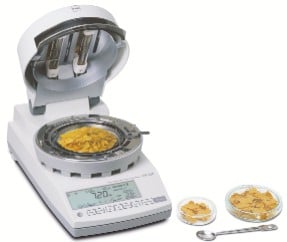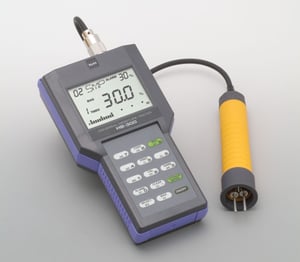 Are you developing pharmaceuticals, processing food, or manufacturing chemicals? If precision and contamination control matter to your business, a composition analyzer can be your most valuable quality assurance tool.
Are you developing pharmaceuticals, processing food, or manufacturing chemicals? If precision and contamination control matter to your business, a composition analyzer can be your most valuable quality assurance tool.
Today’s regulatory environment means that companies have a legal obligation to prevent their products from contamination, but it’s not just about compliance. Consumers want to know that they can trust the products they buy. You also want to avoid the reputational damage that can happen when stories spread through word of mouth, social media, or news reporting about your products being unsafe or damaged.
The uses of a composition analyzer are almost limitless.
What is a composition analyzer?
Composition analyzers use near-infrared (NIR) spectroscopy to rapidly measure a material's chemical makeup, including moisture, fat, protein, and contaminant levels, without destroying samples. These devices provide rapid, non-destructive analysis for quality control, research and production across industries, including food, pharmaceuticals, chemicals and materials manufacturing.
Capable of use in the lab, on production lines, in process vessels and in stationary settings, with the power to identify moisture levels and incorporate a multitude of calibrations, composition analyzers are the high-powered instrument you need for research and development or production.
They can identify all kinds of constituents besides moisture, including:
- Fats and oils
- Water Activity
- Proteins
- Film thickness
- Coat weight
- Carbon content
- BTU
- Contaminants
There’s a reason we continue to refer to composition analyzers as the Swiss-Army knife of testing instruments.
How Composition Analyzers Test Pharmaceuticals for Impurities
Many industries rely on exact precision, but the pharmaceutical industry ranks at the top. They rely on meticulous measurements, as accuracy is critical to the efficacy and safety of drugs. Additionally, the Food and Drug Administration, United States Pharmacopeia and Pharmaceutical Microbiology Manual all require pharmaceuticals to meet strict regulations for toxicity, sterility and shelf life.
When pharmaceuticals are developed, shipped and stored for long periods, they can contain impurities that can make them unsafe for consumption. They can also lose their potency. To monitor this and to keep up with regulations from the FDA, USP and PMM, pharmaceuticals must be tested at each stage, from manufacture to consumer use. This is about ensuring total safety.
A composition analyzer can pinpoint even trace amounts of impurities or changes in potency that can make a drug unsafe or ineffective.
With easy-to-use instruments like the BSS-1700 Near-Infrared Spectrometer, it’s easy to get research-quality results in any pharmaceutical environment.
Using Composition Analyzers to Monitor Quality, Nutrition and Cost Within the Food Industry
Consumers today share growing concerns about the nutritional value of food—the majority of consumers are reading nutrition labels and counting on them to be accurate and informative.
Consumers are also affected by–and are paying attention to–other issues that composition analyzers can help with:
- Accurate nutrition labeling: verifying fat, protein, sugar and fiber content
- Moisture control: ensuring freshness, texture and shelf stability
- Contaminant detection: identifying impurities or unwanted additives
- Consistency and quality: maintaining uniform product composition
- Food authenticity: confirming ingredients and preventing mislabeling
- Shelf life and safety: monitoring water activity to reduce spoilage risk
Likewise, food processors and manufacturers must keep production costs low and food quality high, especially in an age of supply chain disruptions, unpredictable tariffs and increasing consumer prices. They also need to ensure they are meeting FDA requirements to ensure that food is safe and properly labeled.
From farm to table, there’s a lot that can happen to affect a food item’s nutritional value. Exposure to heat, light and air can affect the nutritional content. This means that at multiple stages throughout processing, foods need to be tested for accurate nutritional values and to optimize quality, shelf life and product stability.
The one instrument that can quickly and precisely test food for safety and nutritional values without halting production? A composition analyzer.
As John Bogart, Managing Director of Kett, states, “While composition analyzers are not new to the industry, advanced units today allow even less-skilled personnel to take instant lab-quality tests.”
Composition analyzers like the BS-F1000 Compact Fiber BeatSensor can be used in line with instant results to test for certain compositional characteristics in both end products and in-process substances, including:
- Moisture content
- Protein
- Fats and oils
- Sugar
- Fiber
- Starch
- Water activity
- Alcohol levels
How a Composition Analyzer Monitors Contaminants and Homogeneity of Petroleum Products
Petroleum is found in countless products that we use every day, from the oil that lubricates our cars to lipsticks and petroleum jelly. In all of these substances, manufacturers need to ensure that they have created a product with a homogeneous blend for a smooth consistency and high-quality product.
Composition analyzers like the KJT270 Fiber Optic Analyzer offer real-time, in-line feedback. During the manufacturing process, samples can be tested for a homogeneous, contaminant-free blend without stopping production.
Petroleum-based fuels also need careful monitoring, for which a composition analyzer can be a valuable tool. Contaminants in the fuel tank can reduce combustion efficiency and even increase rates of corrosion if fuel manufacturers are not careful. Even too much water in fuel can lead to major issues.
The use of a composition analyzer like the BS-F1000 Compact Fiber Beat Sensor can help check for particles and contaminants during the refining process to prevent these issues from developing.
Even More Uses for Composition Analyzers
Within the pharmaceutical, food and petroleum industries alone, composition analyzers have a vast array of applications. But these useful instruments can benefit the manufacturing process of other goods as well.
Pulp and Paper (and More)
A composition analyzer can analyze dryer cans for wet streaks and uneven drying without altering samples or needing to make contact. It can also monitor the chemical composition of pulp and paper as well as wood products, resins, fiber and binders.
Chemicals are added to pulp and paper products to improve their performance or to improve the production process. However, the presence of these chemicals in recyclable pulp and paper products can affect their recyclability.
These chemicals can be closely monitored using one of these composition analyzers:
- KJT700 Advanced In-Line Composition Analyzer
- KJT270 Near-Infrared Desktop Composition Analyzer
- KJT270F Desktop Composition Analyzer with Fiber Optics
Chemical Manufacturing
A composition analyzer such as the desktop KJT270 Near-Infrared Composition Meter can measure the various chemical components of any liquid or solid using near-infrared reflectance and is ideal for most organic substances with unparalleled precision. These instruments are ideal for both lab and research and development settings and can be used in almost any situation.
Polymers and Films
Near-infrared composition analyzers and spectrometers can be used in line to measure moisture content as well as to monitor and control the solution, suspension and emulsion polymerization processes.
Too much moisture can result in the reduction of a polymer’s mechanical properties or lead to surface or structural defects or corrosive wear. Too little moisture will result in polymers that are brittle or shatter easily. A composition analyzer can be especially helpful during the development stage of polymers when the KJT270F Desktop Composition Analyzer With Fiber Optics can give accurate readings.
Improper or incomplete drying can cause major issues, either when the product is being produced, when it is in use or both. A composition analyzer will help prevent this from happening.
Frequently Asked Questions About Composition Analyzers
What is a composition analyzer used for?
A composition analyzer measures the chemical or physical components of a sample, such as moisture, fat, protein, fiber, or contaminants, to ensure product quality, consistency and safety. It’s widely used in industries like food processing, pharmaceuticals, chemicals and materials manufacturing.
How does a composition analyzer work?
Most modern analyzers use near-infrared (NIR) spectroscopy to detect how light interacts with a sample. The resulting data reveals the material’s composition quickly and non-destructively, often without the need for sample preparation.
What are the latest advancements in composition analysis technology?
New instruments feature AI-powered calibration, machine learning algorithms and predictive analytics that automatically adjust for variations in samples. These technologies reduce the need for manual recalibration and improve accuracy over time.
Can composition analyzers connect to digital systems?
Yes. Many newer models now include cloud connectivity and real-time data sharing, allowing quality control teams to monitor production remotely, store historical data and integrate results into broader Industry 4.0 or smart factory systems.
Are composition analyzers easy to use?
Today’s analyzers are designed for simplicity and speed. Touchscreen interfaces, automatic calibration and intuitive software make it possible for even non-technical staff to obtain laboratory-quality results in seconds.
How can a business choose the right composition analyzer?
Key factors include the type of material being analyzed, required measurement speed, desired precision and how easily the device integrates into your existing processes or data systems. Consulting with an instrumentation expert can help identify the best fit for your application.
Searching for the right composition analyzer? Kett can help!
Are you searching for a composition analyzer for product development or production? Our engineers are ready to help you find the perfect instrument for your uses.
While at first it may seem that there are as many composition analyzers as there are uses for them, we will help you narrow the field and find an accurate, durable, long-lasting composition analyzer to meet your exact specifications. Our engineers are ready to help you find the perfect instrument and how composition analysis can improve your quality control process. Contact us today to learn more.
Topics: Composition Analyzer


